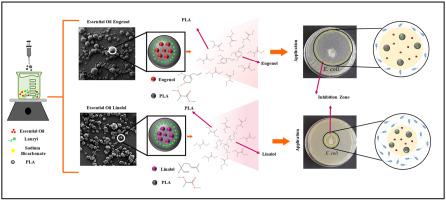Materials Today Chemistry ( IF 7.3 ) Pub Date : 2021-07-03 , DOI: 10.1016/j.mtchem.2021.100493 C.G. Silva 1 , E.D.C. Yudice 2 , P.A.L. Campini 3 , D.S. Rosa 3

|
The essential oils (EOs) have great potential as a natural alternative to preserve foods against spoilage and poisoning pathogens, and they are healthy and safe. Their incorporation in polymers has been of great interest in active packaging for preserving fresh food. This work aims to evaluate the effect of encapsulation of two different oils (linalool and eugenol) as antimicrobial agent activity against Escherichia coli, Salmonella enterica subsp. enterica serovar Choleraesuis, Staphylococcus aureus, and Listeria monocytogenes. The minimum inhibitory concentration (MIC) and minimum bactericidal concentration (MBC) evaluated the EOs and their capsules with polylactic acid biopolymer. It was analyzed using the agar disc-diffusion testing method to determine the inhibition zones. The active release curves were constructed to elucidate activity efficiency. The minimum bactericidal concentration (MBC) values on E. coli, Salmonella, S. aureus, and L. monocytogenes were 0.39%, 3.13%, 0.78%, 1.56%, and 0.39%, 12.50%, 0.39%, and 12.50%, for the eugenol and linalool, respectively. To eugenol against E. coli (60 mm) and linalool against Salmonella (32 mm) exhibited relevant inhibition zones results. The EOs released promoted the inhibition zone by the volume of the EOs released over 24 h (2.2 μL/L to eugenol and 1.5 μL/L to linalool). Moreover, UV–vis results determined the active release reporting that the capsules have a prolonged efficiency, continuing to release the active up to 40 days, indicating potential application in active food packaging, extending the shelf life of food.
中文翻译:

PLA微胶囊化丁香酚和芳樟醇对病原菌活性的评价
精油 (EO) 作为一种天然替代品具有巨大的潜力,可以保护食物免受腐败和中毒病原体的侵害,而且它们是健康和安全的。它们在聚合物中的结合在用于保存新鲜食物的活性包装中引起了极大的兴趣。这项工作旨在评估封装两种不同的油(芳樟醇和丁香酚)作为抗大肠杆菌、沙门氏菌亚种的抗菌剂活性的效果。猪霍乱肠杆菌、金黄色葡萄球菌和单核细胞增生李斯特菌. 最低抑菌浓度 (MIC) 和最低杀菌浓度 (MBC) 用聚乳酸生物聚合物评估 EO 及其胶囊。使用琼脂盘扩散测试法对其进行分析以确定抑菌圈。构建活性释放曲线以阐明活性效率。大肠杆菌、沙门氏菌、金黄色葡萄球菌和单核细胞增生李斯特氏菌的最低杀菌浓度 (MBC) 值为0.39%、3.13%、0.78%、1.56% 和 0.39%、12.50%、0.39% 和 12.50%分别为丁香酚和芳樟醇。丁香酚对抗大肠杆菌(60 mm) 和芳樟醇对抗沙门氏菌(32 mm) 表现出相关的抑菌圈结果。释放的 EO 通过 24 小时内释放的 EO 的体积(2.2 μL/L 到丁香酚和 1.5 μL/L 到芳樟醇)促进了抑菌圈。此外,UV-vis 结果确定了主动释放报告,表明胶囊具有延长的效率,持续释放活性长达 40 天,表明在活性食品包装中的潜在应用,延长了食品的保质期。



























 京公网安备 11010802027423号
京公网安备 11010802027423号